


This new pattern of scoring has been attributed to several factors that have changed in recent years (e.g. We became accustomed to seeing teams scoring 150 runs in the last 10 overs, having only scored 200-odd runs in the previous 40 overs. This means that batting teams generally score far more runs in the last 25 overs than in the first 25.Ģ015 The recent ICC Cricket World Cup 2015 saw a high frequency of large scores, with a flurry of runs coming in the last 10-15 overs.

Many factors contribute to this: various rule changes around fielding restrictions batsmen who have had enough time batting to feel in good form bowlers and fielders getting more tired and so on. Where this maxim comes from, however, is the change in attitude of a batting team towards the end of its innings. To those unfamiliar with cricket this may seem odd, as basic arithmetic tells us that half of 50 overs is 25 overs, not 30. Or, put more commonly, “Take the 30-over score and double it.” It states that, on average, a team’s score at the end of its allotted 50 overs will be roughly double its score from the 30-over mark. In one-day cricket there is an old maxim about trying to predict a team’s score, mostly referred to by commentators. “Double the 30-over score” | Cricket ODI stats “Double the 30-over score” - a cricket analysis


 0 kommentar(er)
0 kommentar(er)
